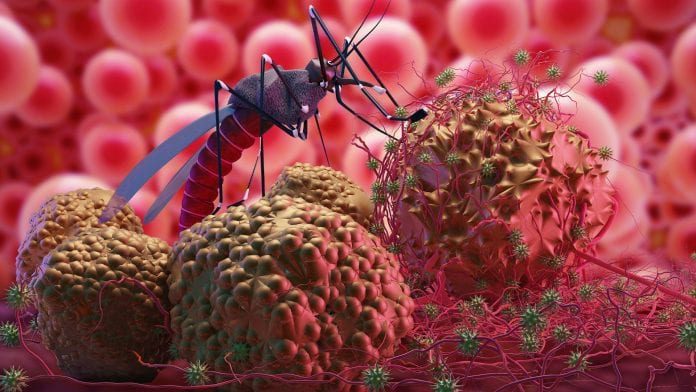The World Health Organization designates the 25th of April as WORLD MALARIA DAY to commemorate the effect of malaria on disease burden countries and high-risk populations such as pregnant women and infants. This year it is themed Zero Malaria – Draw the line against malaria. Malaria is the most common infection in the tropics, including Ghana. It is spread through mosquito bites and is caused by plasmodium parasites. In Africa, malaria in pregnancy is one of the most common preventable causes of miscarriages and stillbirths. Pregnancy-associated malaria is also one of the leading causes of anemia, which is a common cause of pregnancy-related hospitalizations and deaths.
Malaria has 2 habitats (a place an organism e.g. Plasmodium parasites can live and reproduce successfully) in humans i.e. Liver and the Red blood cells. In the pregnant women, the placenta is an additional habitat. The placenta is an organ formed during pregnancy as a functioning & protective intermediary between maternal blood and fetal blood.
Why is pregnancy-associated malaria dangerous?
Malaria is linked to a 3–4 times higher risk of miscarriages and a significantly higher risk of stillbirths. This is due to the massive breakdown of red blood cells (RBCs) infested with plasmodium parasites. RBCs are the oxygen transporters needed by any developing human cell, including the growing fetus. Extrapolating from this, the major breakdown of these oxygen carrier units (RBCs) in pregnancy-associated malaria results in decreased oxygen supply to the developing fetus, resulting in growth and development retardation, and most likely, the fetus’ death.
Secondly, the source of nutrients e.g. glucose for the fetus is from the maternal liver. Plasmodium parasites feed on glucose stores (glycogen) in the mother’s liver, reducing the amount of nutrients available to the mother and developing fetus. This results in a decrease in fetal growth and development, as well as the possibility of stillbirth and spontaneous abortion (miscarriage).
Thirdly, the placenta is a rich site for oxygen and nutrient for fetus. Of all the 3 habitats, this is the most suitable habitat for plasmodium parasites because of this inherent property. Plasmodium parasites move to the placenta during pregnancy-related malaria episodes because of the placenta’s high nutrient content. This is called placental malaria. This is disturbing phenomenon because, (i) Mothers (especially non-first-time pregnant women) may never experience any symptoms of malaria that would cause them to visit the clinic for checkups and (ii) Even if mum is doing well, the disease could be affecting the developing fetus unknowingly.
Overall, the three factors listed above deprive the fetus of oxygen and nutrients, resulting in babies born prematurely and/or with low birth weight (smaller than a normal baby), predisposing them to premature births, Neonatal Intensive Care Units(NICU) admissions, and infant mortality in the first 30 days of life (neonatal deaths).
Why should it be discussed and be in the known of the public?
Pregnancy associated malaria is very preventable. World Health Organization demonstrates in their world malaria report in 2019 that, malaria during pregnancy is responsible for 5–12 percent of all low birth weight and 35 percent of preventable low birth weight, as well as 75 000 to 200 000 child deaths per year. This is preventable and attainable through sleeping under insecticide treated nets(ITNs) and taking of the malaria pills (sulfadoxine+pyrimethamine) given at antenatal care visits.
Malaria is particularly dangerous for pregnant women because pregnancy reduces a woman’s immunity to the disease, making her more vulnerable to infection and increasing the risk of illness, serious anemia, and death from the disease. Anemia in pregnancy is a risk factor of fetal demise. Malaria is more likely to cause serious complications in first-time mothers than in other pregnancies. The first and second trimesters of pregnancy are also crucial periods in which pregnant women are most vulnerable to malaria. Malaria preventive measures like sleeping under insecticide treated nets(ITNs) and regular antenatal visits are strongly advised.
Symptoms and signs of pregnancy associated malaria
Malaria in a pregnant woman may be symptomless however, symptomatic malaria may have an avalanche symptoms which includes: fever, headache, bitter taste, loss of appetite, vomiting, breathlessness, joint pains, myalgia, jaundice, coke coloured urine, an unusual general feeling of unwellness etc. These are red flags the prompts for antenatal care even if it is not up for your scheduled date. One of the ways of catching malaria in a symptomless is through regular antenatal visits. This is because examination and routine lab tests are conducted to screen for malaria and other worrying conditions like an ailing fetus(probably due to malaria) can be detected early to be addressed. PLEASE DON’T MISS ANTENATAL VISITS. THEY ARE LIFE-SAVING.
How to prevent this
The Ghana Health Service and the Ministry of Health have two main approaches to this that are used across the country. Pregnant women are given pills to take during antenatal visits; whether infected with the plasmodium parasites or not. This is called intermittent preventive treatment (IPT). Secondly, sleeping under Insecticide treated nets (ITNs) is highly recommended. This is why ITNs are given to every pregnant women.
“I don’t want sleep in the ITNs because it is warm and unbearable to sleep under it”. It is time to weigh the benefit of sleeping under the net considering your unborn child and sleep comfort. The following are preventive add-ons:
- Residual room spraying
- Using a trap door
- Ensuring that there is mosquito screening in windows
- Close doors and windows when it is getting dark
- Covering stored water
- Wearing long body clothing covering up to the wrist and ankle with socks from 5pm if you’ll be will be outside the ITNs ie. Watching television or chatting at night. DON’T WEAR BLACK CLOTHING AT NIGHT
- Smearing mosquito repellant at night
- Taking the full drug regimen when diagnosed with malaria even when you are feeling better
- Clearing of bushes distilling choked and sluggishly flowing gutters
- Oiling stagnant water and puddles




